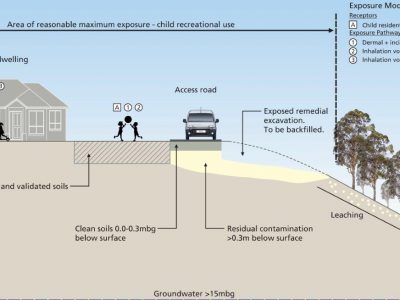Project Info
Project Description
A soil leaching assessment was conducted at a former industrial solvent recycling plant. The evaluation aimed at understanding the potential for contaminants in the soil to migrate into the groundwater. This assessment was crucial in determining whether further environmental actions, such as soil remediation, might be necessary to manage groundwater risks.
Key Points:
- Purpose of the Assessment: The primary objective was to assess whether chlorinated hydrocarbons present in the soil could leach into the groundwater, potentially causing existing groundwater contaminant plumes to expand. Significant leaching could alter the site’s risk profile and trigger soil remediation.
- Contaminants of Concern (COCs): The assessment focused on key volatile organic compounds (VOCs) such as Tetrachloroethene (PCE), Trichloroethene (TCE), and 1,2-Dichloroethane (1,2 DCA) and Chloroform. These contaminants are linked to historical solvent recycling and processing activities at the site.
- Methodology:
- Soil Sampling: Fourteen boreholes were drilled in a grid pattern over the source area and soil samples were collected at various depths to identify VOC levels.
- Leaching Potential: The Australian Standard Leachate Procedure (ASLP) was employed to evaluate the potential for contaminants to migrate from the soil to groundwater. The results were compared with Freshwater Ecosystem Trigger Values (FWTV). Where exceedances were noted, site-specific Leachate Soil Screening Levels (LSSLs) were calculated.
- Permeability Testing: Vertical permeability tests were conducted to assess the soil’s ability to water infiltration which could carry contaminants down to the groundwater. The results indicated very low vertical soil permeability
- Findings:
- The assessment indicated that the majority of the site’s contaminant levels were below the calculated screening thresholds, suggesting a low risk of significant leaching. However, specific locations exhibited elevated levels of 1,2 DCA and PCE, surpassing the LSSLs—170 mg/kg for 1,2 DCA and 6 mg/kg for PCE—indicating potential hotspots where leaching could occur.
- Despite these findings, the overall risk to groundwater from soil leaching was deemed low.
- Conclusion:
- The report concluded that, under current site conditions, the risk of soil leaching leading to groundwater plume expansion is low and acceptable. The limited extent of areas where contaminants exceed LSSLs, combined with the site’s physical characteristics (low permeability and site seal), suggests that significant leaching is unlikely to occur.
The site-specific assessment of soil leaching confirmed that costly soil remediation was not necessary, showcasing Geo-Logix’s deep expertise in understanding the processes that influence contaminant migration. This outcome highlights our commitment to providing effective, informed solutions that prioritize the environment and cost-efficiency.



